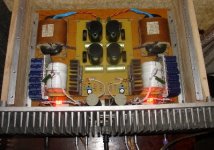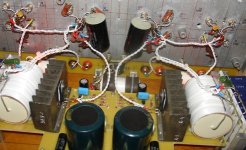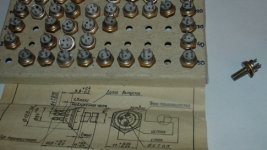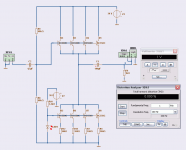I have put together this prototype just for testing an idea of multi-jFET power buffer. Nelson Pass used to listen 1000pcs 2SK170 jFET Beast. In my case, the task was not so tuff, only 8pcs CP650 (actually I used Russian substitute - KP903) jFETs per channel.
First I tested Zen-like transconductance jFET version, but after it, I decided to test also follower-like buffer. And, my God, I can not stop listening to this follower-like baby. Sound goes directly to soul. Can compete with any tube amp.
Specific feature of this schematics – HF jFETs, they have Ciss close to 15pF (less than K170), but transconductance of every jFET is close to 100mS. The C1, R1, R3, C3, C4 must be of maximum quality.
First I tested Zen-like transconductance jFET version, but after it, I decided to test also follower-like buffer. And, my God, I can not stop listening to this follower-like baby. Sound goes directly to soul. Can compete with any tube amp.
Specific feature of this schematics – HF jFETs, they have Ciss close to 15pF (less than K170), but transconductance of every jFET is close to 100mS. The C1, R1, R3, C3, C4 must be of maximum quality.
Attachments
Last edited:
Here are some shots of this prototype. I am afraid to say this, but I listen it with PMC EB1i, at few watts power, and the bass is quite OK. Then what to expect with horn speakers?
Of course, preamp used is very important. In my case it is also SE j-FET, with output cap being short circuted, an interconnect cable is under 60V voltage between the hot and cold wires.
Of course, preamp used is very important. In my case it is also SE j-FET, with output cap being short circuted, an interconnect cable is under 60V voltage between the hot and cold wires.
Attachments
What power jfet are tou using and what do they cost?
As I mentioned, the jFETs are similar to CP650 (produced in USA). The russian version is marked KP903, it has screw-like case, and priced near 1 USD/pc.
At the same time, CP650 are nearly 15 USD/pc.
Attachments
Member
Joined 2009
Paid Member
In my view, this is close to a triode. I looked at the idea of multiple parallel JFETs after reading about Nelson's experiments and some threads about Mostrodes. I realized that the Triode is a device with real physical dimensions so that it is actually like many triodes in parallel which have slightly different characteristics. Multiple JFETs in parallel with slightly different characteristics reproduces some of this character.
I expect that Nelson's new SIT devices maybe more like an "i.c." of parallel JFETs 😀
I expect that Nelson's new SIT devices maybe more like an "i.c." of parallel JFETs 😀
In my view, this is close to a triode. I looked at the idea of multiple parallel JFETs after reading about Nelson's experiments and some threads about Mostrodes. I realized that the Triode is a device with real physical dimensions so that it is actually like many triodes in parallel which have slightly different characteristics. Multiple JFETs in parallel with slightly different characteristics reproduces some of this character.
I expect that Nelson's new SIT devices maybe more like an "i.c." of parallel JFETs 😀
You are right, in that the SITs are a kind of jFETs with special gate design. But not for these CP650 - KP903, they behave quite in an ordinary fashion, and can act as a current source. With SITs it is hardly possible to arrange a current source from them.
Main specific features of the schematics from post1,
- low parasitic capacitances ( I guess close to 20pF total Crss of 4 pcs of Jfets)
- very linear Id vs Vgs
Member
Joined 2009
Paid Member
Well I like this design. But I don't have any JFETs... Vladimir, if you have a source for these can you let me know.
Well I like this design. But I don't have any JFETs... Vladimir, if you have a source for these can you let me know.
I feel myself a bit guilty, since all russian suppliers from the search results below do not work for export.
??903? | ??????????? ????????? | ChipFind.ru
Price span is from 1 to 2 USD per pcs.
In my case, I also live not in Russia, I have asked one my friend from Moscow to buy 50 pcs for me, and he took the transistors when he visited Tashkent
Member
Joined 2009
Paid Member
Member
Joined 2009
Paid Member
I checked my local expert on this power JFET and according to this source, the voltage rating is quite low - perhaps rather close to your operating conditions to be comfortable ??
hardly the same.....as the fets hardly need any drive, and those To92 devices are too small to really drive any speaker....
one could start looking a fet devices for HF/RF power amplifiers...I know from my time at SP-radio that there was used some lateral power N channel fet's wit good power handling capability and lowish Ciss
these could be a suitable devices...the latter with impressively low Ciss off 7 pF...but only a quarter Amp on the drain...so one would need quite a few....🙂
http://www.farnell.com/datasheets/514604.pdf
http://www.farnell.com/datasheets/317041.pdf
one could start looking a fet devices for HF/RF power amplifiers...I know from my time at SP-radio that there was used some lateral power N channel fet's wit good power handling capability and lowish Ciss
these could be a suitable devices...the latter with impressively low Ciss off 7 pF...but only a quarter Amp on the drain...so one would need quite a few....🙂
http://www.farnell.com/datasheets/514604.pdf
http://www.farnell.com/datasheets/317041.pdf
Last edited:
hardly the same.....as the fets hardly need any drive, and those To92 devices are too small to really drive any speaker....
I think you are getting the terms mixed up
or I have no idea
tho some call a power amp without gain a power buffer, I think this is meant to be preamp/'power' buffer
or what ?
Hello Vladmir.
Here is the bipolar version using BC550C.
The idea is the same.
The result may be better (lower dist) but about the sound we do not know.
Main advantage is easy to get BC550C transistors. And build.
Lineup, I am sure you are kidding here, with your experience and you decide that your drawing represents similar concept ...
First of all, I speak about the load connected in parallel to active "device", not to current source like in your case. Also I battle for minimum driver requirements, and you offer what, base currents, than predriver, than triple follower stage ...
My IMHO advise, please, less simulations, more practice and comparisons with good tube gear.
I am really sorry.
But yet my circuit is a power buffer.
And will work.
Similar idea. But not the same. You are right, Vladimir.
But yet my circuit is a power buffer.
And will work.
Similar idea. But not the same. You are right, Vladimir.
- Status
- Not open for further replies.
- Home
- Amplifiers
- Solid State
- jFET Power Buffer




